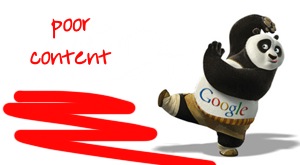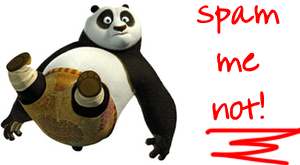 When the new Google Panda algorithm change first debuted, people who had gotten quite cushy in their online marketing panicked. Spammy links didn’t work, article publishing sites like EzineArticles floundered, popular sites like About.com and Wikipedia were suddenly dubbed “poor quality,” and slow-loading pages were dumped into virtual obscurity. The basic fact is that marketers should never get too comfortable with their strategies and techniques because the world of SEO is always changing. Love it or hate it, we’ve all got to deal with the hand that Google deals us. Here are 10 steps to surviving this transition to come out a stronger player while providing more valuable content than ever before.
When the new Google Panda algorithm change first debuted, people who had gotten quite cushy in their online marketing panicked. Spammy links didn’t work, article publishing sites like EzineArticles floundered, popular sites like About.com and Wikipedia were suddenly dubbed “poor quality,” and slow-loading pages were dumped into virtual obscurity. The basic fact is that marketers should never get too comfortable with their strategies and techniques because the world of SEO is always changing. Love it or hate it, we’ve all got to deal with the hand that Google deals us. Here are 10 steps to surviving this transition to come out a stronger player while providing more valuable content than ever before.

 Spun content is a disaster. For a while, website owners who weren’t handy with a pen and couldn’t afford to hire writers would simply steal copy and run it through a program that changed enough words to avoid penalties from Google. (In case you didn’t know, search engines HATE duplicate content!) You can compare spun or copy-and-pasted articles to plagiarism in school.
Spun content is a disaster. For a while, website owners who weren’t handy with a pen and couldn’t afford to hire writers would simply steal copy and run it through a program that changed enough words to avoid penalties from Google. (In case you didn’t know, search engines HATE duplicate content!) You can compare spun or copy-and-pasted articles to plagiarism in school.
Cheaters can save face by going back through their existing spun copy and hiring copywriters to rewrite the content. Remember, you don’t want to simply delete these old pages because larger sites still rank better. If you’re inundated with loads of rehashed copy, you can move the duplicate content to a sub-domain, specific category or directory structure… but the very best you can do is dump the duplicate content ASAP!

 In the past, people thought 200-400 words was sufficient to attract search engines. Yet, Google is greedy and longer keyword-rich posts are picking up a lot of the buzz. So how long is “long enough,” you ask? Routinely include 1,000 – 3,000 word posts as efficient landing pages. Be sure you’re using sub-sections with H1, H2 and H3 tags to break up your writing. Photos are good too. You don’t need ALL 1,000+ word posts, of course, but a natural blend of different lengths will appeal to different types of site visitors – some with lots of time on their hands, others with not so much time. If you have a blogger, ask him or her to write some 250-300 posts, some 400-500 word posts and some massive 1,000+ posts to mix it up. You want to become an authority of high-quality content that offers unique and specific suggestions for a populace that is in dire need of information. Keep in mind, the longer articles get more links and can include more Google-friendly, long-tail keywords.
In the past, people thought 200-400 words was sufficient to attract search engines. Yet, Google is greedy and longer keyword-rich posts are picking up a lot of the buzz. So how long is “long enough,” you ask? Routinely include 1,000 – 3,000 word posts as efficient landing pages. Be sure you’re using sub-sections with H1, H2 and H3 tags to break up your writing. Photos are good too. You don’t need ALL 1,000+ word posts, of course, but a natural blend of different lengths will appeal to different types of site visitors – some with lots of time on their hands, others with not so much time. If you have a blogger, ask him or her to write some 250-300 posts, some 400-500 word posts and some massive 1,000+ posts to mix it up. You want to become an authority of high-quality content that offers unique and specific suggestions for a populace that is in dire need of information. Keep in mind, the longer articles get more links and can include more Google-friendly, long-tail keywords.

 You want to make a dinosaur-sized content footprint in the Google Index, so be sure you are in the right ballpark. Look at how many pages you have listed in your sitemap.xml file. Check to see how many of those pages are indexed. Now take a look at the top 10 sites within your niche for the keyword you’re targeting. Do they have 100 pages or 10,000? Make sure you’re within the same range. If you’re not, better shift content creation front and center. Assess how many posts you need to add to your site to increase your content footprint, decide upon a budget and develop a timeline. Since the world is always changing, Google loves fresh content. Who wants to read about a study that was conducted 10 years ago, when new studies are being published all the time? Post frequently and keep your site relevant.
You want to make a dinosaur-sized content footprint in the Google Index, so be sure you are in the right ballpark. Look at how many pages you have listed in your sitemap.xml file. Check to see how many of those pages are indexed. Now take a look at the top 10 sites within your niche for the keyword you’re targeting. Do they have 100 pages or 10,000? Make sure you’re within the same range. If you’re not, better shift content creation front and center. Assess how many posts you need to add to your site to increase your content footprint, decide upon a budget and develop a timeline. Since the world is always changing, Google loves fresh content. Who wants to read about a study that was conducted 10 years ago, when new studies are being published all the time? Post frequently and keep your site relevant.

 The top portion of your page needs to have the most relevant content visible. So, for all you people that loaded tons of ads first and made poor web users scroll to find your content… it’s time to re-think your strategy. Advertisers love that, of course, but if Google doesn’t love it, then your ad positioning isn’t really helping anyone. Check your site in 1024 x 768 screen resolution and see what shows “above the fold,” as it were. You may want to consider shortening the vertical height of your header if it pushes your content too far down the page. Reposition your ad placement. Make sure there is not too much white space above the title or blank space beneath your menu bar. Make sure you don’t have more advertising on your page than content. Eliminate social media buttons, search boxes and banner ads from your header. As Dwight Shrute would say: Keep It Simple, Stupid!
The top portion of your page needs to have the most relevant content visible. So, for all you people that loaded tons of ads first and made poor web users scroll to find your content… it’s time to re-think your strategy. Advertisers love that, of course, but if Google doesn’t love it, then your ad positioning isn’t really helping anyone. Check your site in 1024 x 768 screen resolution and see what shows “above the fold,” as it were. You may want to consider shortening the vertical height of your header if it pushes your content too far down the page. Reposition your ad placement. Make sure there is not too much white space above the title or blank space beneath your menu bar. Make sure you don’t have more advertising on your page than content. Eliminate social media buttons, search boxes and banner ads from your header. As Dwight Shrute would say: Keep It Simple, Stupid!

 Affiliate links look like the work of a spammer, in Google’s eyes, so you don’t want your links to stand out like a sore thumb. In fact, customers don’t like to see links all over the place either. Cloak your links by keeping your domain name front and center. For example, instead of something like “http://merchant.com/phone#/?affid=1234” you can put something like “http://www.yourdomainname.com/cellphone#.” Even though they both lead the same place, one looks more like blatant affiliate marketing than the other.
Affiliate links look like the work of a spammer, in Google’s eyes, so you don’t want your links to stand out like a sore thumb. In fact, customers don’t like to see links all over the place either. Cloak your links by keeping your domain name front and center. For example, instead of something like “http://merchant.com/phone#/?affid=1234” you can put something like “http://www.yourdomainname.com/cellphone#.” Even though they both lead the same place, one looks more like blatant affiliate marketing than the other.

 Google hates when popular sites sell their page rank, so be sure to add “NoFollow” to all outbound paid links. That being said, you don’t want to convert all your links to “NoFollow” or it throws up a red flag that you’re trying to manipulate Google Page Rank. This isn’t the most important recommendation of all, but you want to be careful not to call unnecessary attention to your practices.
Google hates when popular sites sell their page rank, so be sure to add “NoFollow” to all outbound paid links. That being said, you don’t want to convert all your links to “NoFollow” or it throws up a red flag that you’re trying to manipulate Google Page Rank. This isn’t the most important recommendation of all, but you want to be careful not to call unnecessary attention to your practices.

 Google likes sites that play nice in the sandbox with other sites. High-quality sites that share links with other high-quality sites are favored by Google more than miserly websites who hoard all the traffic to themselves. Give credit to websites that you reference in your article, which shows that you value the experience of your readers over selfish money-making interests. Also, by citing credible sources, you’re showing that you’re more of the journalistic ilk than the unfounded I-Made-It-All-Up crowd that is so prevalent online. Spammers never research, so you want to distinguish your site as a place where all the best information is compiled in a unique and compelling manner.
Google likes sites that play nice in the sandbox with other sites. High-quality sites that share links with other high-quality sites are favored by Google more than miserly websites who hoard all the traffic to themselves. Give credit to websites that you reference in your article, which shows that you value the experience of your readers over selfish money-making interests. Also, by citing credible sources, you’re showing that you’re more of the journalistic ilk than the unfounded I-Made-It-All-Up crowd that is so prevalent online. Spammers never research, so you want to distinguish your site as a place where all the best information is compiled in a unique and compelling manner.

 Spam sites usually don’t have features like: About Us, Contact Us, Privacy Policy, Anti-Spam Policy, Terms of Use, Earnings Disclosure, Affiliate Agreement, DMCA Policy, etc. If you want to look more legitimate in the eyes of the search engines and your clientele, then add relevant disclosures discreetly at the bottom of your page.
Spam sites usually don’t have features like: About Us, Contact Us, Privacy Policy, Anti-Spam Policy, Terms of Use, Earnings Disclosure, Affiliate Agreement, DMCA Policy, etc. If you want to look more legitimate in the eyes of the search engines and your clientele, then add relevant disclosures discreetly at the bottom of your page.

 Just as some guys inadvertently act like creepers on their dates, giving off the desperation vibe, so do some website owners unintentionally act like spammers. You may have thought your methods were just par for the course and standard protocol for web marketers when, in reality, you’re using outdated methods that are penalizing your site. Here are some examples…
Just as some guys inadvertently act like creepers on their dates, giving off the desperation vibe, so do some website owners unintentionally act like spammers. You may have thought your methods were just par for the course and standard protocol for web marketers when, in reality, you’re using outdated methods that are penalizing your site. Here are some examples…
- Hidden Text: Don’t create long lists of keywords at the bottom of your posts that are white in color and super small, so no one notices it aside from the search engines. Since this text is not contextualized and provides zero value to the reader, Google crawlers are now looking out for this trick.
- Duplicate Images: Many sites create images for their testimonials so they can re-use duplicate content on multiple sites.
- Off-Page Text or Images: Some sites hide their links using <div> tags and expanded page definitions to hide them off the boundary of the page. Often you’ll see this at work if you visit a site that gets a link from another site, yet the link can’t be located when you check the page. Google is not down with this unethical practice and little by little, violators are getting busted.

 SEO and link building are still important, but make sure you consider how the landscape is changing. For example, age is not as important with Google Panda. Some new sites are able to hop to the front of the list, just as the dinosaurs are dropping off the radar. Another downgrade are the EDU and GOV links, which used to boost page rank considerably, but now are not as valued – not because they aren’t valuable, mind you, but moreover because they’re sick of being bombarded by spam comments! Link relevance is gaining more importance, as is social media. Google admitted they’ve consulted lists created in people’s Google Chrome browser and the +1 votes that people make when assessing websites. In other words, they are finally getting hip to feedback. This is undoubtedly a lot to take in and manipulate, but let this be a lesson to all: As you build your site, you should always be asking yourself, “Would I want to visit my page, look at this layout, and read this content?”
SEO and link building are still important, but make sure you consider how the landscape is changing. For example, age is not as important with Google Panda. Some new sites are able to hop to the front of the list, just as the dinosaurs are dropping off the radar. Another downgrade are the EDU and GOV links, which used to boost page rank considerably, but now are not as valued – not because they aren’t valuable, mind you, but moreover because they’re sick of being bombarded by spam comments! Link relevance is gaining more importance, as is social media. Google admitted they’ve consulted lists created in people’s Google Chrome browser and the +1 votes that people make when assessing websites. In other words, they are finally getting hip to feedback. This is undoubtedly a lot to take in and manipulate, but let this be a lesson to all: As you build your site, you should always be asking yourself, “Would I want to visit my page, look at this layout, and read this content?”

Sam, killer post. We need to become experts on this since so much of our marketing depends on it, so way to break it down.